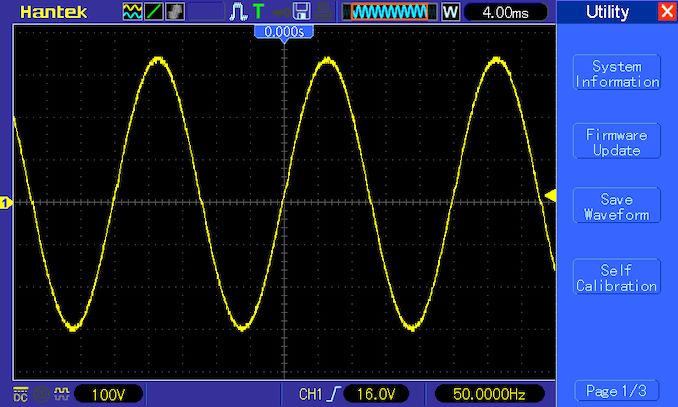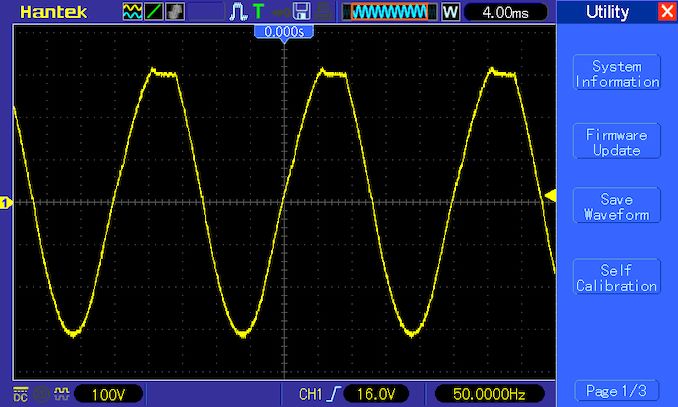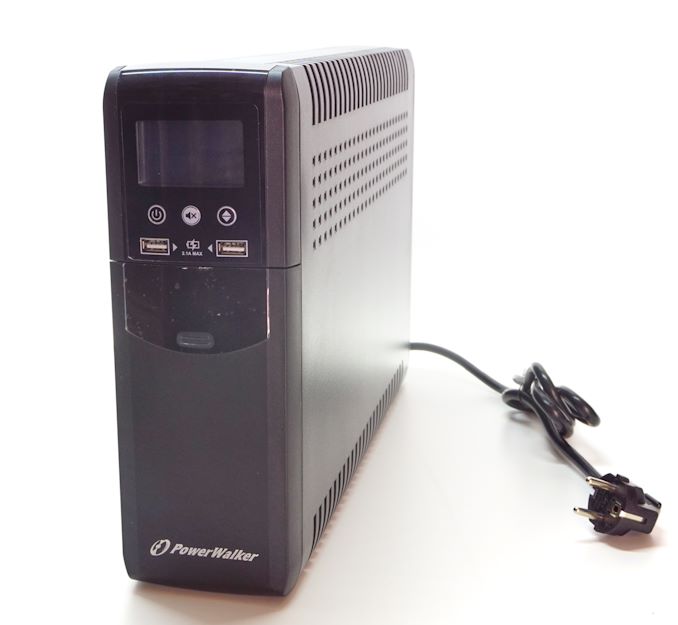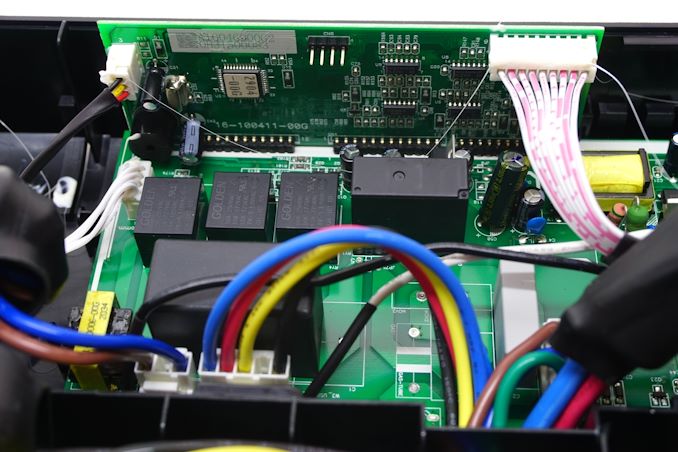The PowerWalker VI 1500 CSW UPS Review: Trying For True Sinewave on a Budget
by E. Fylladitakis on April 13, 2022 8:00 AM EST- Posted in
- Cases/Cooling/PSUs
- UPS
- PowerWalker
- BlueWalker
- 1500VA
Testing
Putting the PowerWalker VI 1500 CSW to the test, the basic electrical figures of the UPS are acceptable, with the unit delivering the performance it promises. When it operates on battery power, the voltage output is exactly 224 V RMS regardless of the load. There are minor frequency variations but these are exceptionally small. The transfer time is relatively high, yet not out of the manufacturer’s specifications. Though it also seems to significantly depend on the load, which should not be happening to this extent.
| UPS Load Performance | |||||
| 10% | 25% | 50% | 75% | 100% | |
| Voltage Output (Vrms) | 224 | 224 | 224 | 224 | 224 |
| Frequency (Hz) | 50.05 | 50 | 50 | 49.95 | 50 |
| Transfer Time (ms) | 6.1 | 7.6 | 7.8 | 7.6 | 8.9 |
The fan of the unit outputs 41.6 dB(A) once it is running. By UPS standards this is not a very high figure, but it's certainly not a very comfortable amount of noise, either. The downside here is that the PowerWalker VI 1500 CSW requires nearly 10 hours to fully charge its batteries once they are completely empty, which could be a problem with the unit installed in a living room or, worse, bedroom.
In our load testing, we've found that the battery runtime of the PowerWalker VI 1500 CSW is even better than advertised. These figures are achieved with its batteries fully charged and while they are new.
The PowerWalker VI 1500 CSW boasts true sinewave output, and our testing confirms this. Under load, our instruments showing a nearly-perfect sine wave with the unit running on battery power – but only while the load is low. Once the load reaches 50% (450 Watts) the deformation of the sine wave becomes apparent. It also becomes deformed abnormally, with only the positive peaks getting chopped, meaning that it is only one half of the circuitry failing to perform. At nearly 90% load (800 Watts) the waveform is nearly square, with both peaks heavily chopped, suggesting a massive number of harmonics. This will definitely not be healthy for any device that requires a pure sinewave input, such as APFC circuitry and AC motors.
Conclusion
The PowerWalker VI 1500 CSW is a UPS designed to combine a high output and true sinewave capability at a retail price affordable for most home consumers. At around €180, it currently retails for half of the price reputable manufacturers ask for their equally powerful true sinewave products, making it a very enticing deal.
The build quality of the PowerWalker VI 1500 CSW is better than one would expect from a product retailing at this price. Its parts are coming from reputable manufacturers and the unit is very well assembled. The design is dated but that is not inherently wrong – it just means the unit isn't geared to deliver the kind of top-of-the-line performance that more recent designs can provide.
When it comes to performance, the PowerWalker VI 1500 CSW performs, for the most part, according to its specifications. The trade-offs and issues become apparent when a closer look is taken, revealing that its electrical performance leaves a lot to be desired. The unit fails to maintain a true sinewave output when the load exceeds about 25% of its rated capacity, which could lead to serious issues if an application requires a true sinewave input. To be sure, for most home applications like modern PCs and TVs, this will not be a significant issue, as they take measures against harmonics and the expected load is usually but a fraction of the unit’s maximum output. However, if the unit needs to run at its maximum output or to drive loads that are very sensitive to harmonics, such as electric motors or older PCs, it could have damaging results to the equipment.
Ultimately, for users who are currently on the market for a UPS that is expected to mostly run at low loads, such as for safeguarding a single PC and its peripherals, the PowerWalker VI 1500 CSW is a fine choice. The UPS offers a clean enough electrical feed to meet the needs of a PC (or similarly switching power supply device), and it has the headroom to handle the stress if the power outage happens when the system is very heavily loads (e.g. while gaming). However, it is very clearly a device that was designed against engineering trade-offs to bring down costs for its target market. So, due to its inability to maintain a clean true sinewave output, we cannot recommend it for sensitive applications, and prospective users will want to be especially careful analyzing the sensitivity of their equipment to harmonics before purchasing it.
















107 Comments
View All Comments
Vatharian - Saturday, April 16, 2022 - link
Sadly, almost anything that has electric motor inside, requires AC. Where you don't have access to gas line, induction is also a must. Do you really want to run 7-8 kW to induction stove or 2-3 kW to oven with arm-thick cables with DC? The best solution is to have dedicated circuits to both. I can picture a variation of UK type plug (because you DON'T want US-style ones for that... or for anything, really) that could handle both AC and DC from same outlet with complete separation of circuits and safe disconnection even from high current DC.I absolutely see the worth of dedicated DC circuitry, however for it to be safe, the craftsmanship during installation would have to be impeccable, with highest quality materials, and let's face it, depending on the size of the house (or apartment) it would be very expensive.
Chaser - Sunday, April 17, 2022 - link
I don't believe Cyberpower and APC's home consumer marketed UPS products are losing any sleep.Valantar - Friday, April 22, 2022 - link
I don't know what equipment from those brands you're looking at, but most of what I can find, while higher capacity and more feature-packed than this, are an order of magnitude higher in price than this is too. So while high-end UPSes might be in a process of being "disrupted" (god how I hate that nonsensical term), the one under review here certainly isn't.t.s - Thursday, April 14, 2022 - link
Yes, there's lithium UPSes, but as far as I know, it used Li-Ion or Li-Po, not LFP. 500-800 Cycle vs 3.500 cycle. LFP has far more cycle, and safer too.And yes, Those UPSes with Lithium is expensive as hell. Better modify the lead acid ourselves. For $1.800, you can get 24v 200AH LFP + BMS + connector + cable + fan + APC SMT750IC (pure sinewave) and still have changes. 24v 200AH = ~5KWH, translates to days when offline.
bananaforscale - Thursday, April 21, 2022 - link
I wouldn't because LiFePO4 batteries differ dramatically from lead-acid batteries in charge requirements (current curve, voltage and such; for one, lead-acid is charged typically at 14.4V which is much too high for LiFePO4). Unless of course you plan to replace the charge circuit at which point you might just as well build it from scratch.asmian - Wednesday, April 13, 2022 - link
"nagual UPS review" -> "inaugural", perhaps...Since the writer makes the statement that UPS is making a comeback, and makes some fairly strong technical comments about the quality of the components and circuitry, it would be very interesting to see a review with a mix of new and better-known brands in their current incarnations pitted against each other, to indicate the current state of the market.
Ryan Smith - Wednesday, April 13, 2022 - link
Thanks!mode_13h - Wednesday, April 13, 2022 - link
Another suggestion: my current UPS (APC Smart-UPS C 1500) had pretty bad coil whine, for the first few years I owned it. This happened when it was on normal A/C power, and I reproduced it both at home and where I work. I even returned it under warranty, but the replacement did the same thing.So, I'd highlight this as an area to watch out for. In a quiet room, that can be a real annoyance.
E.Fyll - Wednesday, April 13, 2022 - link
Thanks for the feedback. I will surely point out such issues if they occur.The most common cause of coil whine is poor quality power input. Harmonics are to blame 90% of the time. That clearly is not the case here though, since you had the same problem at two entirely different places. Someone probably just did not glue down an inductor that should have been glued down.
Mikewind Dale - Wednesday, April 13, 2022 - link
I own two Cyberpower CP1500PFCLCD PFC Sinewave UPS (1500VA, 1000W), one my Ryzen 7 2700X and the other for my ThreadRipper Pro 3955WX. And a friend of mine - on my recommendation - bought the same for his ThreadRipper Pro 3955WX.So far, I have had no issues. I don't get many power outages, but when I do, they have always worked.
So that's one more to test.